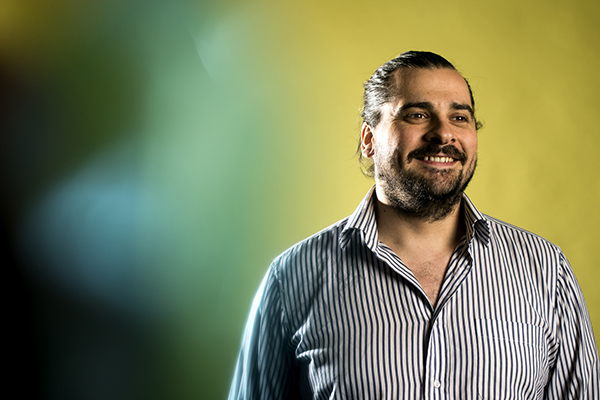Northeastern University scientist tweets out ‘in mice’ to call out misleading science headlines about health studies

“Eating garlic can help to prevent age-related memory loss, study reveals”
“A new study shows that high fat diets are linked to anxiety and depression”
“This is the best time of day to work out, according to science”
Enticing headlines like these may draw traffic to news sites, but they’re missing two vital words: in mice.

James Heathers is a postdoctoral researcher in the Khoury College of Computer Sciences. Photo by Matthew Modoono/Northeastern University
That’s because, though the information gleaned from these studies may someday benefit humans, the research that yielded the results was done on mice. And humans and mice are not exactly interchangeable.
Now James Heathers, masquerading as a rat on Twitter, is providing the context needed to drag these headlines back to reality.
Heathers, a postdoctoral researcher in Northeastern’s Computational Behavioral Science Lab, launched @justsaysinmice in mid-April. The account retweets science coverage with overstated headlines and shouts “IN MICE” (or occasionally “EN RATONES” or “EM RATOS” for articles in Spanish and Portuguese).
IN MICEhttps://t.co/t5lwOIfuaX
— justsaysinmice (@justsaysinmice) April 28, 2019
“Obviously it has a serious point, but it is really supposed to be funny,” Heathers says.
The twitter account started as an inside joke in reaction to conversations he’s had with other researchers.
“Scientists read headlines and then say ‘in mice’ or ‘in rats’ or ‘in cell lines’ to each other all the time,” Heathers says.
EN RATONES https://t.co/IGaCuWEpIY
— justsaysinmice (@justsaysinmice) April 23, 2019
Heathers says he isn’t criticizing the scholarly research being written about, just the way it’s being conveyed. Studies involving mice are an important step in research into human health and medicine. Often, those results cannot be translated into similar results for humans. But even if they can, there are still many years of development and testing before a successful rodent result becomes a human treatment.
For individuals dealing with serious illnesses, Heathers says, consistently hearing that their conditions have been “cured” can be exhausting.
“I’ve gotten messages from people with kids who have chronic illnesses, people with parents who have degenerative diseases,” Heathers says. “They don’t like being told five to 10 times a month that something amazing is going to fix their life.”
IN MICE https://t.co/ejx0QLcV4E
— justsaysinmice (@justsaysinmice) April 22, 2019
The account has rapidly acquired more than 54,000 followers, many of whom are taking a closer look at the articles they see. Heathers regularly receives examples of misleading science headlines, and not just from fellow scientists.
“I’ve got people like management consultants and ballet dancers and people who work in administrative healthcare who are pointing it out as well,” Heathers says. “Anyone can play.”
IN MICEhttps://t.co/22pnaha9zk
— justsaysinmice (@justsaysinmice) April 20, 2019
Although a few people have lost sight of the humor in what Heathers has described as “a wilfully dumb idea,” the responses from journalists and others working in science communication have been overwhelmingly positive. Inaccurate headlines can erode public trust in both science and journalism, and Heathers has found a simple, amusing way to highlight the worst offenders.
Not that Heathers set out to single-handedly change how news organizations report on preclinical research (“I’m just one goon with a Twitter account,” he says). But what started as a joke has become an opportunity for people to engage with scientific research in a new way, including calling out problematic headlines when they see them.
IN MICEhttps://t.co/otn37X1O6V
— justsaysinmice (@justsaysinmice) April 12, 2019
“Maybe it doesn’t change a huge amount,” Heathers says. “But if you have enough leverage to get tens or hundreds or thousands of people to look at it every time it happens, then it’s effective. It’s worth doing. And at no point in time does it stop being funny.”
For media inquiries, please contact media@northeastern.edu.





